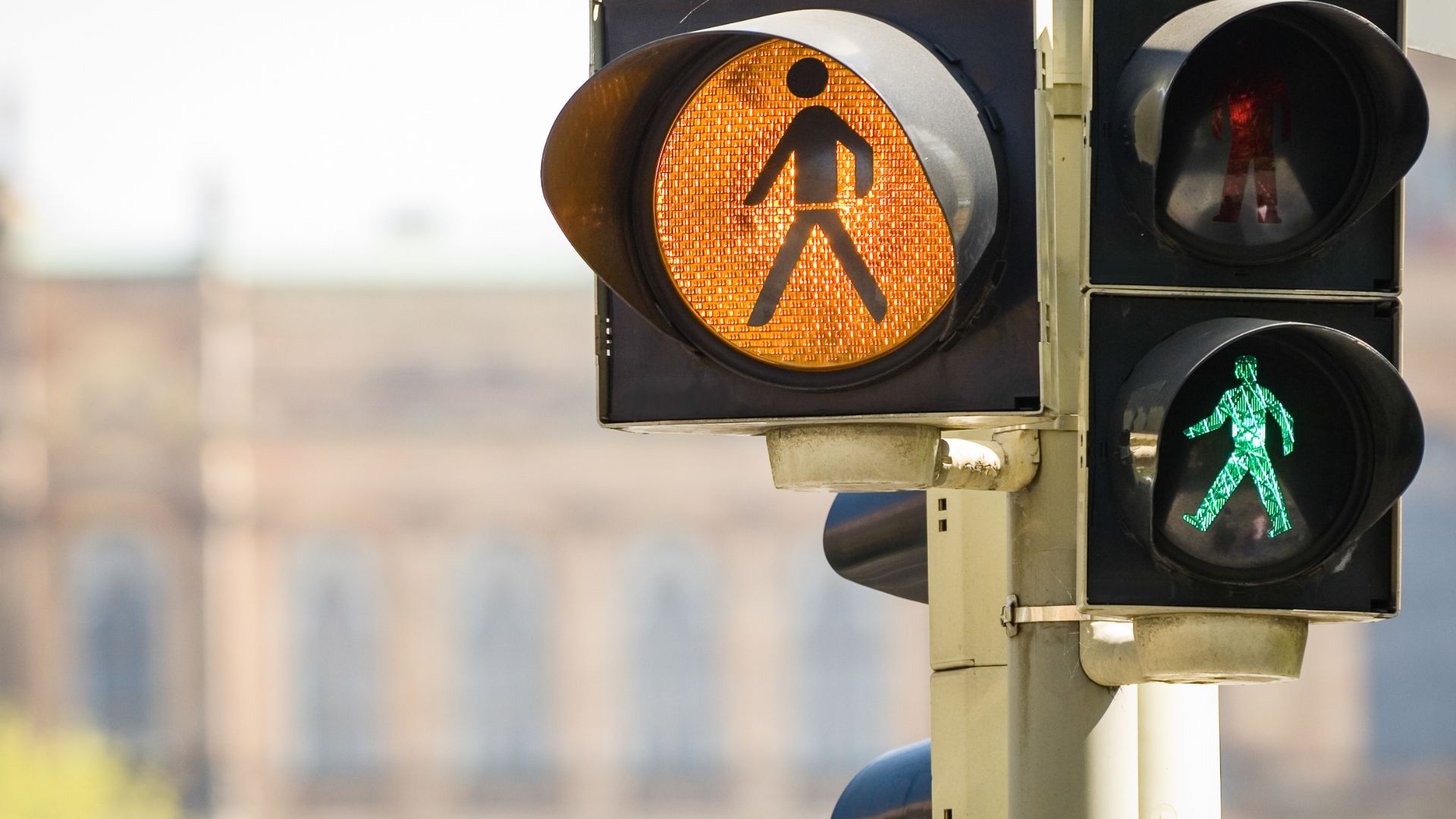Lifestyle
10 Pedestrian Safety Tips That Could Save Your Life

For the most part, walking is good for you. But there are times when it can be dangerous—specifically when walking near traffic.
Consider these sobering statistics published by the National Highway Traffic Safety Administration (NHTSA):
In 2020, there were 6,516 pedestrians killed in traffic crashes, the highest since 1990 and a 3.9% increase from 2019. On average, a pedestrian died every 81 minutes in 2020 — accounting for 17% of all traffic fatalities.
Why does this happen? Pedestrian traffic deaths have many causes, but according to NHTSA data from 2013, most occur in urban areas (73%), in non-intersection locations (69%), and when it’s dark (72%).
In this article, we’ll go over the best safety tips to help ensure you don’t get hurt as a pedestrian or hurt someone else as a driver.
Let’s get started!
When you’re walking …
- Stay on the sidewalk
The sidewalk is one of the safest places to be as a pedestrian because it’s made specifically for walking. So use it as much as possible.
If no sidewalk is available, see if you can take an alternate route that has a walking path. Walking on the side of the road should be a last resort, but if you must do it, stay as far away from traffic as possible and walk facing it so that you can better see oncoming vehicles.
- Use crosswalks
When it comes to crossing the street, use the crosswalk. Again, crosswalks are made for pedestrians. It’s where drivers will most expect to see you. So avoid jaywalking and wait until you get to a designated crosswalk (usually located along intersections and corners).
Before crossing, wait for the crosswalk light to turn green (if there is one). Then look both ways. Look left, then right, and then left again. Stay alert for traffic until you get to the other side of the street.
- Put your phone away
It’s no secret that for many, phones have become a huge distraction. And that’s true for when people walk, too.
According to a study by New York’s Stony Brook University, participants were 61% more likely to veer off course when using their cell phone while walking and 13% more likely to overshoot a target placed a few meters away.
That means if you’re looking down at your phone while walking, you are more likely to accidentally walk into traffic or a parked car. So put the phone down and pay attention to where you are going.
- Don’t walk drunk
Though you may be tempted to walk home drunk to avoid driving under the influence, don’t. Walking home drunk can be just as dangerous.
According to the NHTSA, in 2020, an estimated 47% of fatal pedestrian crashes involved a pedestrian who was drunk.
So instead of taking the risk of getting involved in an accident, get a cab or have a sober friend give you a ride home. It’s safer for you and other drivers.
- Make yourself visible
One simple way to lower the risk of getting hit as a pedestrian is to make yourself more visible to drivers. You can do this by walking during the day, wearing bright or reflective clothing, or carrying a flashlight when it’s dark.
Whatever you do, don’t assume that drivers see you.
And if you ever get hit by a car as a pedestrian, hire an experienced car accident attorney. They can help you get the compensation you deserve for any injuries, lost income, and more.
When you’re driving …
- Keep an eye out for pedestrians
Pedestrians can be hard to see, especially when it’s dark. So watch out for them.
Be especially cautious around neighborhoods and school zones, where children can sometimes dart out into the street unexpectedly. Stay alert and drive extra slowly.
- Yield to crossing pedestrians
Anytime a pedestrian crosses the street, it’s your job to yield as a driver. They have right of way, not you.
For the same reason, you should never try to pass another vehicle stopped at a crosswalk. They may be yielding to a pedestrian that you can’t see from your angle.
- Get rid of distractions
In 2020, 3,142 people were killed by distracted driving, and that includes pedestrians. Whether it’s texting, eating, drinking, or talking to other passengers, distractions can take your eyes off the road and increase the risk of an accident.
So give your full attention to the road. Everything else can wait.
- Keep the speed limit
Speeding also increases the risk of a pedestrian accident.
According to the Governors Highway Safety Association (GHSA), the percentage of pedestrian fatalities involving speeding in 2020 rose to 8.6%, a notable increase from 7.2% the year before. The organization also notes that the average risk of death for pedestrians increases exponentially the faster a vehicle is traveling, from 10% at 23 MPH to 90% at 58 MPH.
Why? For one, speeding gives you less time to react to pedestrians on the road, so you are more likely to hit them. Secondly, speeding exponentially increases the impact of a crash, leading to more serious injuries or death in the event of an accident.
So keep the speed limit. It’s there for a reason.
- Never drink and drive
Lastly, never drink and drive. It impairs your depth perception, your reaction time, and your ability to drive overall. In short, it’s a recipe for disaster.
According to the Centers for Disease Control and Prevention (CDC), of all the people who died in crashes involving alcohol-impaired drivers in 2020, 38% were passengers of the alcohol-impaired drivers, drivers or passengers of another vehicle, or nonoccupants (such as a pedestrian).
Driving drunk is extremely dangerous. That’s why it comes with serious legal consequences. It can lead to hefty fines (up to thousands of dollars), jail time (up to a year in some states), and losing your license.
Whether you are a driver or a pedestrian, make pedestrian safety a top priority. It could save your or someone else’s life.
Lifestyle
Wanda Knight on Blending Culture, Style, and Leadership Through Travel

The best lessons in leadership do not always come from a classroom or a boardroom. Sometimes they come from a crowded market in a foreign city, a train ride through unfamiliar landscapes, or a quiet conversation with someone whose life looks very different from your own.
Wanda Knight has built her career in enterprise sales and leadership for more than three decades, working with some of the world’s largest companies and guiding teams through constant change. But ask her what shaped her most, and she will point not just to her professional milestones but to the way travel has expanded her perspective. With 38 countries visited and more on the horizon, her worldview has been formed as much by her passport as by her resume.
Travel entered her life early. Her parents valued exploration, and before she began college, she had already lived in Italy. That experience, stepping into a different culture at such a young age, left a lasting impression. It showed her that the world was much bigger than the environment she grew up in and that adaptability was not just useful, it was necessary. Those early lessons of curiosity and openness would later shape the way she led in business.
Sales, at its core, is about connection. Numbers matter, but relationships determine long-term success. Wanda’s time abroad taught her how to connect across differences. Navigating unfamiliar places and adjusting to environments that operated on different expectations gave her the patience and awareness to understand people first, and business second. That approach carried over into leadership, where she built a reputation for giving her teams the space to take ownership while standing firmly behind them when it mattered most.
The link between travel and leadership becomes even clearer in moments of challenge. Unfamiliar settings require flexibility, quick decision-making, and the ability to stay calm under pressure. The same skills are critical in enterprise sales, where strategies shift quickly and no deal is ever guaranteed. Knight learned that success comes from being willing to step into the unknown, whether that means exploring a new country or taking on a leadership role she had not originally planned to pursue.
Her travels have also influenced her eye for style and her creative pursuits. Fashion, for Wanda, is more than clothing; it is a reflection of culture, history, and identity. Experiencing how different communities express themselves, from the craftsmanship of Italian textiles to the energy of street style in cities around the world, has deepened her appreciation for aesthetics as a form of storytelling. Rather than keeping her professional and personal worlds separate, she has learned to blend them, carrying the discipline and strategy of her sales career into her creative interests and vice versa.
None of this has been about starting over. It has been about adding layers, expanding her perspective without erasing the experiences that came before. Wanda’s story is not one of leaving a career behind but of integrating all the parts of who she is: a leader shaped by high-stakes business, a traveler shaped by global culture, and a creative voice learning to merge both worlds.
What stands out most is how she continues to approach both leadership and life with the same curiosity that first took her beyond her comfort zone. Each new country is an opportunity to learn, just as each new role has been a chance to grow. For those looking at her path, the lesson is clear: leadership is not about staying in one lane; it is about collecting experiences that teach you how to see, how to adapt, and how to connect.
As she looks to the future, Wanda Knight’s compass still points outward. She will keep adding stamps to her passport, finding inspiration in new cultures, and carrying those insights back into the rooms where strategy is shaped and decisions are made. Her legacy will not be measured only by deals closed or positions held but by the perspective she brought, and the way she showed that leading with a global view can change the story for everyone around you.
-

 Tech5 years ago
Tech5 years agoEffuel Reviews (2021) – Effuel ECO OBD2 Saves Fuel, and Reduce Gas Cost? Effuel Customer Reviews
-

 Tech6 years ago
Tech6 years agoBosch Power Tools India Launches ‘Cordless Matlab Bosch’ Campaign to Demonstrate the Power of Cordless
-

 Lifestyle6 years ago
Lifestyle6 years agoCatholic Cases App brings Church’s Moral Teachings to Androids and iPhones
-

 Lifestyle5 years ago
Lifestyle5 years agoEast Side Hype x Billionaire Boys Club. Hottest New Streetwear Releases in Utah.
-

 Tech7 years ago
Tech7 years agoCloud Buyers & Investors to Profit in the Future
-

 Lifestyle5 years ago
Lifestyle5 years agoThe Midas of Cosmetic Dermatology: Dr. Simon Ourian
-

 Health7 years ago
Health7 years agoCBDistillery Review: Is it a scam?
-

 Entertainment6 years ago
Entertainment6 years agoAvengers Endgame now Available on 123Movies for Download & Streaming for Free
